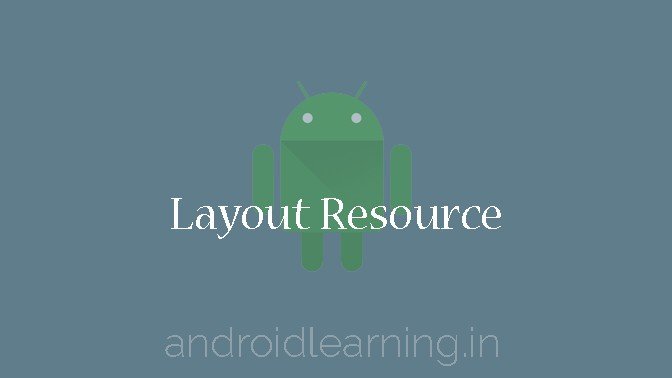A layout resource defines the architecture for the UI in an Activity or a component of a UI.
- FILE LOCATION:
res/layout/filename.xml
The filename will be used as the resource ID.- COMPILED RESOURCE DATATYPE:
- Resource pointer to a
View(or subclass) resource. - RESOURCE REFERENCE:
- In Java:
R.layout.filename
In XML:@[package:]layout/filename - SYNTAX:
-
<?xml version="1.0" encoding="utf-8"?> <ViewGroup xmlns:android="http://schemas.android.com/apk/res/android" android:id="@[+][package:]id/resource_name" android:layout_height=["dimension" | "match_parent" | "wrap_content"] android:layout_width=["dimension" | "match_parent" | "wrap_content"] [ViewGroup-specific attributes] > <View android:id="@[+][package:]id/resource_name" android:layout_height=["dimension" | "match_parent" | "wrap_content"] android:layout_width=["dimension" | "match_parent" | "wrap_content"] [View-specific attributes] > <requestFocus/> </View> <ViewGroup > <View /> </ViewGroup> <include layout="@layout/layout_resource"/> </ViewGroup>
Note: The root element can be either a
ViewGroup, aView, or a<merge>element, but there must be only one root element and it must contain thexmlns:androidattribute with theandroidnamespace as shown. - ELEMENTS:
-
Value for
android:idFor the ID value, you should usually use this syntax form:
"@+id/name". The plus symbol,+, indicates that this is a new resource ID and theaapttool will create a new resource integer in theR.javaclass, if it doesn’t already exist. For example:<TextView android:id="@+id/nameTextbox"/>
The
nameTextboxname is now a resource ID attached to this element. You can then refer to theTextViewto which the ID is associated in Java:findViewById(R.id.nameTextbox);
This code returns the
TextViewobject.
However, if you have already defined an ID resource (and it is not already used), then you can apply that ID to aViewelement by excluding the plus symbol in theandroid:idvalue.Value for
android:layout_heightandandroid:layout_width:The height and width value can be expressed using any of the dimension units supported by Android (px, dp, sp, pt, in, mm) or with the following keywords:
Value Description match_parentSets the dimension to match that of the parent element. Added in API Level 8 to deprecate fill_parent.wrap_contentSets the dimension only to the size required to fit the content of this element. Custom View elements
You can create your own custom
ViewandViewGroupelements and apply them to your layout the same as a standard layout element. You can also specify the attributes supported in the XML element. To learn more, see the Custom Components developer guide. - EXAMPLE:
- XML file saved at
res/layout/main_activity.xml:<?xml version="1.0" encoding="utf-8"?> <LinearLayout xmlns:android="http://schemas.android.com/apk/res/android" android:layout_width="match_parent" android:layout_height="match_parent" android:orientation="vertical" > <TextView android:id="@+id/text" android:layout_width="wrap_content" android:layout_height="wrap_content" android:text="Hello, I am a TextView" /> <Button android:id="@+id/button" android:layout_width="wrap_content" android:layout_height="wrap_content" android:text="Hello, I am a Button" /> </LinearLayout>
This application code will load the layout for an
Activity, in theonCreate()method: -
public void onCreate(Bundle savedInstanceState) { super.onCreate(savedInstanceState); setContentView(R.layout.main_activity); }
- SEE ALSO:


